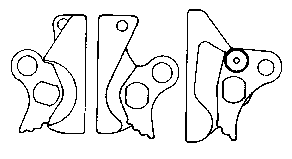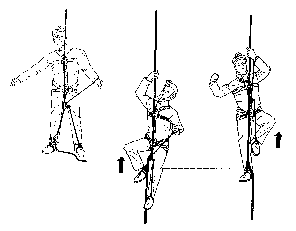Technical Details
I acquired my Bogibbs from Bill Franz in 1992. I acquired another in 2017 as part of Bob Thrun’s collection.
The Bogibbs is 96 mm. tall, 53 mm. wide, 26 mm. thick, and weighs 172 g. The shell is made from 2 mm. stainless steel, and the cam is cast stainless steel.
There are no markings on my Bogibbs.
The Bogibbs is a Czechoslovakian ascender that can be placed on the
rope without disassembling the device. The shell is 2 mm. stainless
steel bent or stamped to form a U-channel. The holes in the shell
appear to be for weight savings only. The cam looks like it is
forged stainless steel. Mine has a slight flaw in the underside
which should not affect the strength of the unit. The teeth are
rounded and unlikely to damage the rope in normal use. The axle
bolt is drilled out, again an apparent attempt to save weight.
The rope is rigged by inserting a bight from the side. Start
with the cam closed (i.e., lever down, and insert the top of the
rope first. Rotate the cam open as you work the rope in. If you
start at the bottom, the rope will keep the cam from rotating
fully and inserting the top will be difficult. It takes longer
to describe this than to do it. Sitting here, I can rig the ascender
in about 3 seconds, without looking, and with practice one could
get faster.
The arm on the cam is longer than on the Gibbs,
which gives better grip but increases the motion required to release
and move the ascender. I would prefer a shorter arm, but mainly
because I'm used to the Gibbs.
Karel Kocourek sent me the following note from the Czech Republic:
In your article about Bogibbs ascenders you write that
you don't know the purpose of the holes on the upper part of
the ascender body. If there are some larger holes, they are probably
only for weight reduction, as you write (although I think the
gain is almost negligible). Small (sometimes oval) hole near
upper edge is intended for attachment of thin cord or webbing.
 Your
Bogibbs is one of possible modifications, another versions are
on Fig. 1, where: The left one was meant as "versatile";
usually 2 pieces made a set, sometimes there were "left,"
"middle" and "right" versions. The second
one is so called " Bogibbs. Its shape enabled insertion
of a loaded rope. I have never seen it in reality. The right
one is so called "chest" Bogibbs. Some people didn't
use chest box, and preferred the third Bogibbs on the chest harness.
It had to be installable onto a loaded rope. The thick circle
on the cam means a screw lock (additional safety against slipping
out).
Your
Bogibbs is one of possible modifications, another versions are
on Fig. 1, where: The left one was meant as "versatile";
usually 2 pieces made a set, sometimes there were "left,"
"middle" and "right" versions. The second
one is so called " Bogibbs. Its shape enabled insertion
of a loaded rope. I have never seen it in reality. The right
one is so called "chest" Bogibbs. Some people didn't
use chest box, and preferred the third Bogibbs on the chest harness.
It had to be installable onto a loaded rope. The thick circle
on the cam means a screw lock (additional safety against slipping
out).
In my set of Bogibbses are 2 "versatile" Bogibbses
(right and left) and a "chest" one. All without any
enlightening holes; there are only small holes of the second
type on both of the "versatiles." All were made by
some Moravian (Moravia is a part of the Czech Republic) speleological
club according to officially distributed documentation (no industrial
production of caving equipment existed in Eastern Europe that
time). Your Bogibbs is of color combination and type I have already
seen, but I cannot remember where was it.
 The
other end of the thin cord attached to the small hole of the
knee-level Bogibbs was tied into a loop and put around a wrist
of a caver. Fig. 2 describes the use of such system: Left person
is a caver prepared for ascent; the second and third person are
cavers in different phases of ascent. Many cavers in Slovakia
preferred this system, but I used to attach the knee-level Bogibbs
to my leg using an elastic tape. Any of these Bogibbses weren't
supposed to withstand shock load. For self belaying, some type
of Gibbs (often homemade) was used. At the end of 1980’s almost
all Czech/Slovak cavers switched to French method enhanced by
the third ascender attached to an ankle of one leg.
The
other end of the thin cord attached to the small hole of the
knee-level Bogibbs was tied into a loop and put around a wrist
of a caver. Fig. 2 describes the use of such system: Left person
is a caver prepared for ascent; the second and third person are
cavers in different phases of ascent. Many cavers in Slovakia
preferred this system, but I used to attach the knee-level Bogibbs
to my leg using an elastic tape. Any of these Bogibbses weren't
supposed to withstand shock load. For self belaying, some type
of Gibbs (often homemade) was used. At the end of 1980’s almost
all Czech/Slovak cavers switched to French method enhanced by
the third ascender attached to an ankle of one leg.
In Czech (and Slovak) Republic is widely spread an opinion,
that Bogibbs was invented by Gustav Stibranyi, a Hungarian (or
Slovak with Hungarian last name??) living in Slovakia. Nevertheless,
Czechs, Slovaks and Hungarians always used the same equipment,
so it is not easy to say where any particular Bogibbs came from.
With regards
Karel Kocourek
Pilsen, Czech Republic
Sources:
Fig. 1 - in: "Studijní texty - speleolog I. stupně"
(= "Textbook - Speleologist of the 1st rank" ), Czech
Speleological Society, Prague, Czechoslovakia, 1986
Fig. 2 - in: "Praktická speleologie" (= "Spelology
in practice"), Osveta, Martin, Czechoslovakia, 1982
On March 29, 2012, Martin Sluka sent me the following additional information:
Hi Gary,
I just read you article about bogibbs. The pictures from Karel Kocourek’s mail are of Bogibs sold in late 70s by Gustav Stibranyi, recent owner of Meander company. They could be originally from Hungary, but the commercial (grey commercial, because of communist regime) version is from him. Gustav lives in Slovakia but he is Hungarian by nationality. There are another vertical products with Slovak origin from a man named Peter Hippman (he died yet), copies of Petzl ascenders and descenders and Peter Mrázik - descender, copy of Petzl one. I own one such myself made descender from aluminum with titanium rolls - quite crazy idea because titanium is bad distributor of heat. But I used it many years. And as I remembered Bogibbses with titanium body - made by cavers from town Kladno near Prague (Czechia) following original plans….
Best regards
Martin Sluka



 Your
Bogibbs is one of possible modifications, another versions are
on Fig. 1, where: The left one was meant as "versatile";
usually 2 pieces made a set, sometimes there were "left,"
"middle" and "right" versions. The second
one is so called " Bogibbs. Its shape enabled insertion
of a loaded rope. I have never seen it in reality. The right
one is so called "chest" Bogibbs. Some people didn't
use chest box, and preferred the third Bogibbs on the chest harness.
It had to be installable onto a loaded rope. The thick circle
on the cam means a screw lock (additional safety against slipping
out).
Your
Bogibbs is one of possible modifications, another versions are
on Fig. 1, where: The left one was meant as "versatile";
usually 2 pieces made a set, sometimes there were "left,"
"middle" and "right" versions. The second
one is so called " Bogibbs. Its shape enabled insertion
of a loaded rope. I have never seen it in reality. The right
one is so called "chest" Bogibbs. Some people didn't
use chest box, and preferred the third Bogibbs on the chest harness.
It had to be installable onto a loaded rope. The thick circle
on the cam means a screw lock (additional safety against slipping
out). The
other end of the thin cord attached to the small hole of the
knee-level Bogibbs was tied into a loop and put around a wrist
of a caver. Fig. 2 describes the use of such system: Left person
is a caver prepared for ascent; the second and third person are
cavers in different phases of ascent. Many cavers in Slovakia
preferred this system, but I used to attach the knee-level Bogibbs
to my leg using an elastic tape. Any of these Bogibbses weren't
supposed to withstand shock load. For self belaying, some type
of Gibbs (often homemade) was used. At the end of 1980’s almost
all Czech/Slovak cavers switched to French method enhanced by
the third ascender attached to an ankle of one leg.
The
other end of the thin cord attached to the small hole of the
knee-level Bogibbs was tied into a loop and put around a wrist
of a caver. Fig. 2 describes the use of such system: Left person
is a caver prepared for ascent; the second and third person are
cavers in different phases of ascent. Many cavers in Slovakia
preferred this system, but I used to attach the knee-level Bogibbs
to my leg using an elastic tape. Any of these Bogibbses weren't
supposed to withstand shock load. For self belaying, some type
of Gibbs (often homemade) was used. At the end of 1980’s almost
all Czech/Slovak cavers switched to French method enhanced by
the third ascender attached to an ankle of one leg.